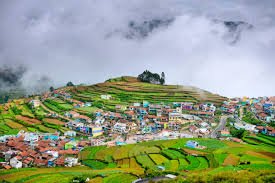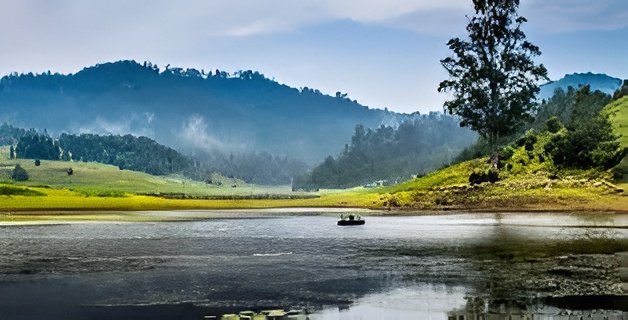Kodaikanal is a renowned hill station in Tamil Nadu, India, famed for its cool climate, lush scenery, and rich cultural tapestry. Known as the “Princess of Hill Stations,” Kodaikanal attracts millions of travelers annually and stands out for its scenic beauty, diverse heritage, and exceptional tourist infrastructure.
Nestled at an elevation of about 2,133 meters (7,000 feet) in the upper Palani Hills of the Western Ghats, Kodaikanal is approximately 120 km from Madurai and is strategically positioned for easy road and rail access from key South Indian cities. Its unique geography has made it an ideal summer retreat since its establishment in 1845 by British and American settlers looking to escape the heat of the plains.
Key Details:
Additional Cost Notes
- Group travel or off-season can reduce costs, while luxury options can increase them
- Entry fees for attractions: Rs. 0–30 per spot (most major spots are under Rs. 30; some nature spots are free).
- Mid-range cost for a typical 3-day trip: Rs. 8,000–15,000 per person including hotel, food, local travel, and sightseeing.
History of Kodaikanal
Kodaikanal’s earliest settlers were primitive tribes dating back to around 5000 BC, followed by the Kannuvar Vellalans in the 14th century. They introduced organized farming, employing the original inhabitants as laborers. Subsequently, the region saw periods of Maratha and Muslim control, which led to significant migrations into the hills.
In the 19th century, British and American missionaries began building residences to escape tropical diseases common in the lower regions. Dr. Fane constructed the first notable English home in 1845, and continual development led to the iconic artificial Kodaikanal Lake in the 1860s. By the early 20th century, improved road access sparked a tourism boom that transformed ‘Kodai’ into a cosmopolitan hill town.
Cultural Heritage and Local Traditions
Kodaikanal’s culture is a vibrant blend of tradition, spirituality, and community spirit. Locals celebrate festivals such as Pongal (harvest festival), the energetic Summer Festival, and Christmas with grand fervor. The town boasts artisan crafts, notably exquisite handicrafts reflecting its heritage. Terrace farming, crucial to the local economy, shapes the landscape and supports a large portion of the population.
Temples and Spiritual Landmarks
Kodaikanal Mariamman Temple is significant for its spiritual role and annual festival. Several churches, including Devonshire Church and La Salette Church, highlight the town’s colonial influence and multicultural roots.
Major Tourist Spots in Kodaikanal
Kodaikanal offers a memorable experience with its rich variety of sights and attractions:
- Kodaikanal Lake: The heart-shaped, man-made lake is perfect for boating, cycling, and picnics.
- Coaker’s Walk: A scenic pedestrian walk offering panoramic valley views.
- Bryant Park: A botanical garden near the lake, famous for seasonal blooms.
- Pillar Rocks: Tall granite boulders offering superb vistas.
- Bear Shola Falls: A tranquil waterfall surrounded by forest.
- Guna Caves (Devil’s Kitchen): A unique geological site popularized by Indian cinema.
- Dolphin’s Nose: A striking viewpoint with dramatic overhangs.
- Pine Forest: A serene, photogenic forest trail.
- Berijam Lake: A tranquil and secluded lake (requires Forest Department permit).
- Silver Cascade Waterfall: A captivating roadside waterfall.
Other highlights include Kurinji Andavar Temple, the Solar Observatory, Green Valley View (Suicide Point), Chettiar Park, and the Shenbaganur Museum, all contributing to Kodai’s diverse appeal.
Route and Accessibility
Kodaikanal is well connected by road, rail, and air. The nearest airport is Madurai (120 km), with regular buses and taxis plying from Dindigul, Madurai, Coimbatore, Ooty, Bangalore, and other major cities. Road trips pass through scenic mountain roads and lush forests, making the journey itself an adventure.
Popular road routes include:
- From Coimbatore: Via Pollachi and Palani (about 170 km)
- From Bangalore: Via Hosur, Salem, Dindigul (about 460 km)
- From Ooty: Via Coonoor, Mettupalayam, Coimbatore, Palani (about 258 km) or a longer route through Dharapuram and Dindigul.
- From Munnar: Via Theni Bypass and Palani (about 167 km).
Trains stop at Kodai Road Station, about 80 km from town, with frequent taxis and buses available for the uphill climb.

Economic Impact and Revenue
Tourism is the primary driver of Kodaikanal’s economy. The hill station draws over 3 million visitors annually, leading to the proliferation of hotels, restaurants, and supporting enterprises. The Tamil Nadu Tourism Development Corporation (TTDC) reported that tourism revenues in the state surged to over ₹129 crore through its hotels, tours, and upgraded facilities.
Agriculture also plays a vital role, with terrace farming supporting the production of high-value crops such as plums, pears, peppers, carrots, cabbage, and garlic. Local handicrafts and seasonal farm produce markets are also integral to Kodai’s economy.
Location and Geography
Kodaikanal lies in Dindigul district, on the southern crest of the Palani hills, at a latitude of approximately 10°7′ to 10°20′ N and longitude of 77°16′ to 77°45′ E. Its elevation (2,100+ meters) confers cool weather year-round, lush green vistas, and dramatic mountain scenery, making it a perennial favorite.
FAQs About Kodaikanal
What is the best time to visit Kodaikanal?
The peak travel season is from April to June, when the weather is pleasantly cool and ideal for sightseeing. The monsoon brings lush greenery but frequent showers. Winter (November to February) offers misty landscapes and crisp air.
How do travelers reach Kodaikanal?
Kodaikanal is accessible by road from Madurai, Dindigul, Coimbatore, Ooty, Munnar, and Bangalore. The nearest airport is Madurai (120 km), and Kodai Road is the closest railway station (80 km away).
What are the must-see attractions in Kodaikanal?
Top sights include Kodaikanal Lake, Coaker’s Walk, Bryant Park, Pillar Rocks, Bear Shola Falls, Guna Caves, Berijam Lake, and Kurinji Andavar Temple.
Which festivals are celebrated in Kodaikanal?
Key festivals include Pongal (January), the Summer Festival (May), and major events at the Mariamman Temple and Christian churches, with vibrant local participation.
Is Kodaikanal suitable for family vacations and solo travelers?
Yes, Kodaikanal’s diverse attractions, safe environment, and relaxed pace make it ideal for family holidays, couples, and solo explorers.
What are the main crops and products in Kodaikanal?
Terrace farming yields crops like plums, pears, potatoes, carrots, cabbage, and spices. Handicrafts and local chocolates are popular souvenirs.
What is the historical significance of Kodaikanal?
Kodaikanal’s history blends tribal origins, ancient migrations, colonial groundwork, and multiculturalism due to missionary and British developments in the 19th century.
Conclusion
Kodaikanal’s enduring allure lies in its stunning natural setting, comfortable climate, cultural vibrancy, and ease of access from major South Indian cities. Whether for family vacations, romantic getaways, or solo travel, Kodai offers something for everyone, from tranquil landscapes to bustling local markets, spiritual temples, and a welcoming, harmonious community.
